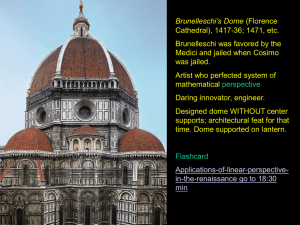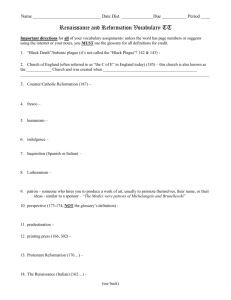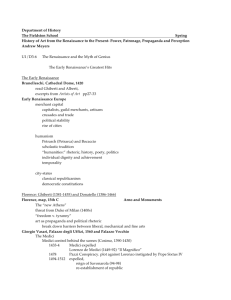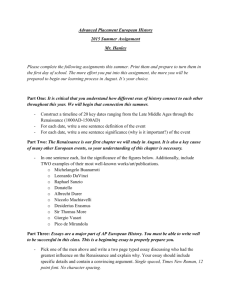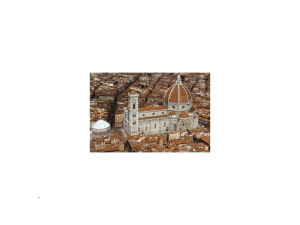early ren italy - Doral Academy Preparatory
advertisement
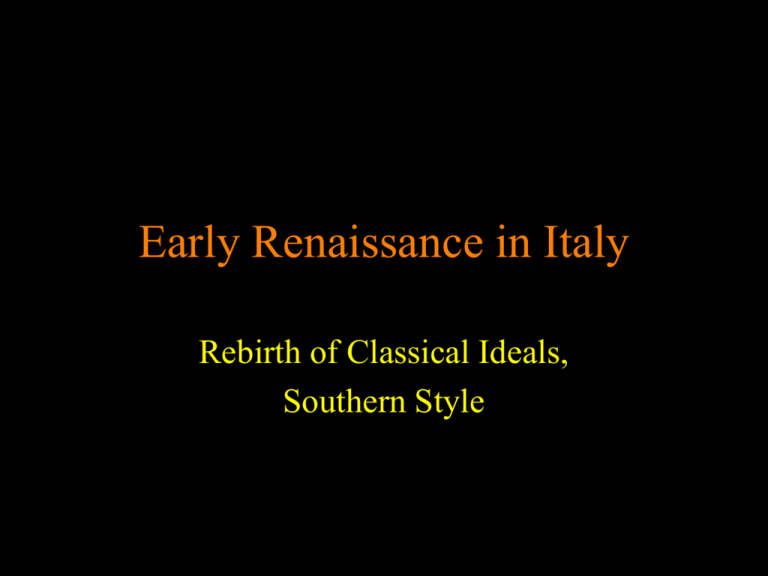
Early Renaissance in Italy Rebirth of Classical Ideals, Southern Style 15th century Italy was not a country, but a group of individual and sometime warring city-states such as Florence, Milan, Padua, etc. Merchant families- such as the Medici- rose to power. THEY BECAME MAJOR ART PATRONS AND HELPED LAUNCH THE ITALIAN RENAISSANCE Early Renaissance Italy…. • Humanism philosophy dominates literature, arts, science, and even religion • Study things as they really are, age of discovery (remember Columbus was going to North America during this time frame) • Great influence of Van Eyck and Flemish/Northern Renaissance • However added classical studies of antiquity from Greece/Roman traditions Artistic Innovations • Like the North, Italian artists showed realistic human forms, but with greater concern to anatomy and classical influences • Brunelleschi - artist/architect developed the use of perspective to an astonishing degree • Return of classical large scale sculptures, nudes, and many secular art works • Patrons were powerful families who ruled the city states, such as the Medici • Medici, Godfathers of the Renaissance What about Perspective???? • Atmospheric and intuitive perspective already in place from Netherlands/Northern Renaissance • Italian Renaissance artists went a step further, studying it mathematically Uccello shows a battle for one of the city states here in this tempera painting, of 1438. He also shows the use of pserpsecitve as “discovered” or developed by Brunelleschi. Itlaian Renaissance went a step fruther than their Flemish colleagues in perspective… Perugino, The Delivery of the Keys to Saint Peter, Fresco, 1481, right wall of the Sistine Chapel, Rome. Shows linear perspective and low horizon line, orthogonals to v. point Brunelleschi’s Dome (Florence Cathedral), 1417-36; 1471, etc. Brunelleschi was favored by the Medici and jailed when Cosimo was jailed. Artist who perfected system of mathematical perspective Daring innovator, engineer. Designed dome WITHOUT center supports; architectural feat for that time. Dome supported on lantern. Flashcard Applications-of-linear-perspectivein-the-renaissance go to 18:30 min Church of San Lorenzo (nave), 1430s-70, Brunelleschi - did 1st architectural perspective drawing using his theory of mathemetical perspective for patrons Brunelleschi designed & built the Foundling Hospital (orphanage) in 1419. The medallions are still loved today … Patron: Silk & Goldsmith’s Guild of Florence as a public service Example of Renaissance style architecture-Corinthian style column with high light arches.. Proportions in line with Renaissance art/science of proportions flashcard Detail of Terra Cotta Medallion, 1487 Foundling Hospital, Florence Andrea della Robbia Family secret blue and white glazing babies show human side of Renaissance humanism Guild public service flashcard Alberti’s Della Pittura & perspective • Alberti wrote a treatise (3 books) on perspective and art. • Half of one book dealt with geometry and mathematical perspective as pioneered by Brunelleschi- making a painting as a “view through a window” (p 622 in text) • The other books dealt with composition, theme, philsophy, and technique Church of Sant’Andrea, Mantua, 1470 Leon Battista Alberti Who also wrote the treatise on perspective, art, etc. Trinity with the Virgin, St. John the Evangelist, and Donors Masacccio, 1425 Masterpiece of perspective - 1st true painting with linear perspective Illusino of reality You can see the grids and perspective lines where he laid strings in the plaster http://luxmedia.vo.llnwd.net/o10/clients/natio nalgallery/illusion/02_trinity.m4v flashcard Expulsion from Paradise, fresco, (adam and Eve), 1427, Masaccio From the Brancacci Chapel Study of anatomy & underlying muscle and bone structure, combined with expressivism and emotions of Adam & Even upon being cast out of Eden More psychological than Flemish painters Inspired by ancient Roman sculpture flashcard QuickTime™ and a decompressor are needed to see this picture. Masaccio, 1427 Adam, Eve from Ghent Altarpiece, Van Eyck, 1437 View of Frescoes by Masaccio & Masolino & Lippi (collaboration in Brancacci Chapel in Florence). Unfortunately Masaccio died in 1428 or 1429 before completing his part of the fresco. Tribute Money, Masaccio, 1427, fresco, Brancacci chapel. flashcard Most innovative of early early Italian Renaissance painters..3 scenes w/in one setting, Peter catches a fish with a gold coin in its mouth to pay Caesar’s taxes on the right, central figures around Jesus where Jesus tells them to Render unto Caesar that which is Caesar’s (Florentines being taxed for military campaign at the time of this painting). Integrates architecture, figures, and landscapes realistically w/perspective Green robe shaded w/red, strong modeling of figures, consistent light source..this fresco Annunciation, Fra Angeliao, fresco, 1438-45. Painted for a monastery in Florence. Probably commissioned by Cosimo de’ Medici. Linear perspective, natural light. Part of a series painted in the monastery to help guide the monks’ prayers. Columns here show new buliding technique used by Brunelleschi. flashcard The Last Supper, Andrea del Castagno, 1447. Fresco. Art & Humanism: Human Form • Artists in Italy became interested in portraying the human form as accurately as possible • Scientists such as Galileo (imprisoned for life by the Spanish Inquisition) promoted the study of nature and reality in physics, mathematics, and biology Battle of the Nudes, Antonio del Pollaiuolo, Engraving, 1465 - study of anatomy Hercules & Antaeus, bronze figurine, 18” tall, del Pollaiuolo, c. 1475 (early Renaissance) Influence of classical Greek & Roman sculpture Study of Anatomy Patrons: smaller statues that could be enjoyed or placed in the homes of middle class families Del Pollaiulo’s patron was the Medici family; he was trained as a painter, sculptor, and goldsmith flashcard Gates of Paradise, (east doors), Baptistry of San Giovanni, Florence, Ghiberti 1425-52, bronze, 15’ high (4.5 meters) Flashcard “I strove to imitate nature as clearly as I could, and with all he perspective I could produce, to have excellent compositions with many figures.” Competition held in 1401 to commission this prestigious set of doors… Brunelleschi & Ghiberti were top competitors Patron: Wool Mfgrs. Guild Name coined later by Michelangelo 1 point perspective, 10 old testament scenes Technological advance from earlier doors-revived LOST WAX method of relief sculpture Jacob & Esau, panel from the Gates of Paradise, Ghiberti 1435 Intuitive and linear perspective, high and low relief figures give amazing sense of depth Jacob & Esau story from Genesis in Bible Esau symbolizes Jews and Jacob Christians Flashcard part 2 Ghiberti’s Gates of Paradise, 1425 Pisano’s John the Baptist doors, 1327 Donatello - New Expressiveness • Excelled in 3 areas: – Human emotions & expressions – Vision & insight in solving formal problems – Technical skill in various sculpture media • 1st life-size male nude since antiquity • 1st life-size equestrian statue since antiquity • Used contrapossto, iconography, G-R drapery David, Donatello, Bronze, 5’2”, 1446-60, early Italian Renaissance 1st life-size male nude statue since antituity David shown standing on the head of Goliath Exagerrated contrapossto position Hat of a fashionable Renaissance young man; David shown as adolescent Originally stood in courtyard of Medici palaceMedici were patrons of Donatello Inscription suggests iconography symbolizing the victory of Florence over Milan in 1428 “The victor is whoever defends the fatherland. Alpowerful God crushes the angry enemy. Behold, a boy overcomes the great tyrant. Conquer, O citizens!” Gattamelata (Equestrian Monument of Erasmo da Narni), Donatello, Bronze, about 12 feet high, 1443 1st life size bronze equestrian statue since antiquity Shows General of Venetian army Self-made man of the Renaissance, powerful condottieri Sources: Marcus Aurelius & another ancient Roman equestrian statues. Donatello stayed in Padua (northern Italy) for years and founded a school of sculpture. flashcard Mary Magdalen, Donatello, wood, 6’ tall, 1450s Extremely expressive statue of the saint, who became a hermit after Jesus’ death. Shows her emaciated and aged, clothed in her own hair, after years of wandering in the wilderness. Donatello rejected classical form in this figure. Vision of the hereafter. http://www.youtube.com/watch?v=ekkOfn002tI&f eature=PlayList&p=6F27851475601E03&index= 9 Andrea del Verrochio followed with this statue in the late 15th century. Bartolomeo Colleoni, General of Venice is portrayed here. Vitality and energy; image of will and domination in this portrait of a condolietteri. Artistic innovations spread from Florence throughout Italy • Artists got ideas, inspiration, & training from Florence artists Brunelleschi, Donatello, and Masaccio and these ideas spread thru Italy • Venice & Urbino also became artistic centers in last half of 15th century • Della Francesca (Urbino), Mantegna (Mantua), and the Bellini brothers (Venice) are 4 artists from these areas where Florentine art spread. Recognition & Proving of the True Cross, Piero della Francesca painted this fresco in the 1450s. Brought from Florence to Urbino by powerful patron Federico da Montefeltro. Used linear perspective & simplified geometric forms. Façade in background mimics Alberti’s. Della Francesca wrote about geometry and art in a book. Part of a cycle of frescoes in this church about the true cross of Jesus. Flemish influence seen in oil paint & luminous colors; also landscape background. Strict profile tradition makes subjects seem distant from viewers Painting on reverse side shows humanistic interests of Montefeltro’s court and is full of iconography. Battista Sforza & Federico da Montefeltro, oil on wood, 1474. Piero della Francesca painted this dual portrait of the Duke of Urbino & his wife Battista. flashcard Reverse side of dual portrait by della Francesca, Triumph of Federico and Battista Inscriptions praise Battista’s restraint and virtues, and Federico’s moderation and fame. Duke is crowned by a winged Goddess (either Victory or Fortune); also shown are Justice, Prudence, Fortitude, and Temperance. Battista’s cart is pulled by a Cherub and driving a team of unicorns.. Faith & Charity hold a pelican, symbol of maternal sacrifices. Camera Picta (Newlywed Ceiling), Andrea Mantegna, fresco, 1465-74, Mantua. Flashcard Mantegna studied in Padua with influence of Donatello. Patron was the Gonzaga family, painted this for their palace ceiling. False oculus, trompe l’oeil effect. Di sotto in su… Shows radical perspective views and foreshortening. BEGAN LONG TRADITION OF ILLUSIONISTIC CEILING PAINTING. Interested in classical literature & archaeology. In Venice, the Bellini brothers created many OIL paintings inspired by the Flemish Procession of the Relic of the True Cross before the Church of St. Mark, Gentile Bellini, oil on canvas, 1496, Galleria dell’ Accademia, Venice. Narrative of annual festival celebrating a 1444 miracle recovery of a dying child. Father in red robe kneeling is praying for his child’s recovery. perspective Virgin & Child Enthroned, 1478, Giovanni Bellini, Hospital of San Giobbe, Venice Sacra conversacione (know this term): sacred conversation between Mary, saints, angels, and donors as shown in this type of piece. In real life of course they are not conversing (from different times and places) but joined in mystical communion outside of time. St. Francis in Ecstasy oil 1470s Bellini Back in Florence late 15th century… • • • • Love of material opulence and interest in nature Poetic, mystical spirit & religious fervor. Philosophical circles around the Medici. Monk Savoronala preached against religious images and destroyed many paintings. • Ghirlandio & Botticelli 2 painters from this time frame. • Botticelli studied under Verrochio, revived the female nude, and painted in a linear style with floating figures. Did 3/4 profile portraits (like Van Eyck) Primavera, Sandro Botticelli, 1482, Florence. Tempera on wood. Allegory combining Christianity with classical stories, Venus of Earth, Venus of Heaven. Orange trees mean fertility. Revived female nude in art. Figures seem to float. Secular painting of religious subject made for Lorenzo Medici’s wedding. Inspired by Flemish tapestry. flashcard Birth of Venus, Botticelli, tempera, 1484. Flashcard. Based on modest Venus classic statue, philosophy of beauty=birth of beauty. http://www.youtube.com/watch?v=r5LB_fW7Ow Mystic Nativity, Botticelli, 1500. Painted to show the end of the world .. At time many though world was going to end in 1500. Cave stable like Byzantine church, timber shed more Western. Philosophers are struggling with angels at the bottom… showing the struggle between science and faith at the time?? Inscription references Book of Revelations in Bible. Ghirlandio Painted frescos in Sassetti chapel in Florence Showed poetic, mystical spirit Religious fervor at end of 15th century Ghirlandaio painted this after viewing van der Goes’ altarpiece, which came to Florence from Bruges in 1483. He even copies some of Hugo’s flowers, the iris, and has Jesus on the ground. However, he puts in classical Roman pilasters instead of a medieval setting. Linear & aerial perspective. Nativity and Adoration of the Shepherds, Sassetti Chapel Altarpiece, Florence, Ghirlandaio, 1485. flashcard Hugo van der Goes’ Portinari Altarpiece Ghirlandaio’s Nativity

